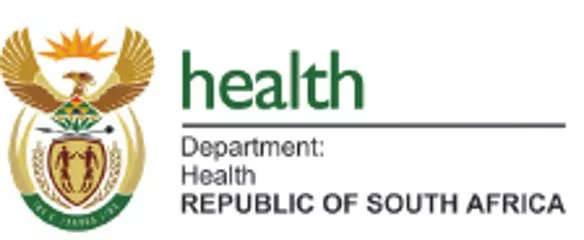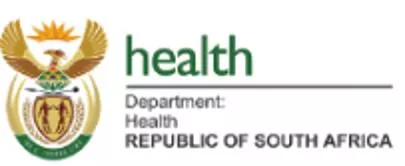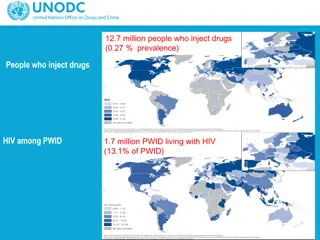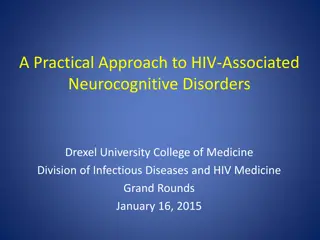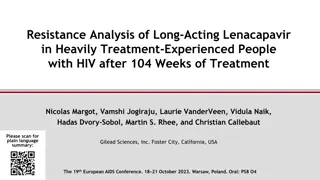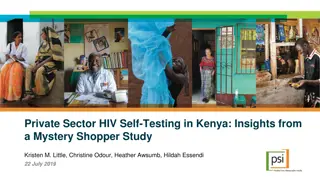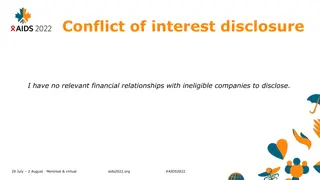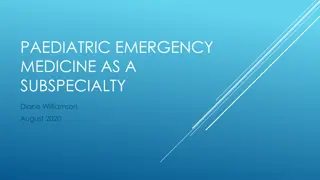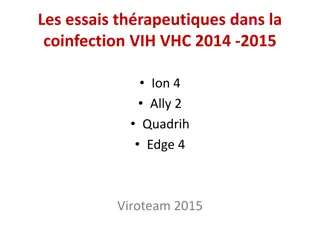Paediatric HIV Testing and Treatment Guidelines
Understanding the importance of early diagnosis in HIV-infected infants and children is crucial for timely intervention and improved health outcomes. This session covers testing algorithms, initiation of antiretroviral therapy, viral load monitoring, and legal issues related to HIV testing in children. Learn about HIV tests in infants, recommended testing intervals, and the significance of initiating infant prophylaxis or ART within 72 hours after delivery.
Uploaded on Aug 04, 2024 | 2 Views
Download Presentation

Please find below an Image/Link to download the presentation.
The content on the website is provided AS IS for your information and personal use only. It may not be sold, licensed, or shared on other websites without obtaining consent from the author. Download presentation by click this link. If you encounter any issues during the download, it is possible that the publisher has removed the file from their server.
E N D
Presentation Transcript
Basic HIV Course for Health Professionals Session 9: Paediatric HIV
Learning Objectives By the end of this session participants should be able to: Describe the testing algorithm for children Explain intervals for infants testing Explain the legal issues related to HIV testing in children Describe when to start antiretroviral in children Explain the viral load monitoring for children
Importance of Early Diagnosis HIV-infected infants are at risk of rapid progression and death often before a diagnosis is made Early diagnosis facilitates: Intervention and close monitoring Prevention and treatment of opportunistic infections Access to ART
HIV Tests in Infants and Children (HIV PCR or Rapid HIV Antibody Test) Conduct birth test in all HIV-exposed babies Done to identify intra-uterine infected infants who are in health care system at time of birth Intra-partum infections detected by a later test, done at 10 weeks Birth testing would: ensure that more HIV-infected infants access testing enable early initiation of treatment which will improve health outcomes and reduce infant mortality
Initiation of Infant Prophylaxis or ART > 72 Hours After Delivery Refer to page 114 of your participant manual to look at the algorithm for initiation of infant prophylaxis or ART > 72 hours after delivery
Infants and Children Who Should be Offered HCT (1) RECOMMENDED INTERVALS FOR INFANT TESTING HIV-EXPOSED INFANTS HIV PCR test Rapid HIV Antibody test At birth ALL HIV-exposed neonates At 18 months: All HIV exposed infants At 10 weeks: All HIV-exposed infants Breastfed infants: All HIV exposed infants 6 weeks post cessation of breastfeeding when > 18 months old At 6 month: For all HIV-exposed infants Aligned with 6-month maternal VL Breastfed infants: All HIV exposed infants 6 weeks post cessation of breastfeeding when < 18 months old Confirmatory viral antigen test up to age of 2 yrs
Infants and Children Who Should be Offered HCT (2) Use an age-appropriate HIV test to test all children with: Family and social history: Breastfed infant of a newly diagnosed HIV-positive breastfeeding mother Parental request to test the child (Primary caregiver is able to give consent for HIV testing in the best interests of the child) Father or sibling with HIV infection Death of mother, father or sibling When the mother s HIV status is unknown, her whereabouts are unknown, or she is unavailable to be tested. Children considered for fostering or adoption Wet-nursed or breastfed by a woman with unknown or HIV-positive status Clinical features or conditions: Clinical features suggestive of HIV infection Acute, severe illness IMCI classification of Suspected symptomatic HIV infection or Possible HIV infection TB diagnosis or history of TB treatment Suspected or known sexual assault
Legal Issues Related to HIV Testing of Children
Overview of Legal Issues Related to HIV Testing of Children (1) HIV testing of any child may take place if: it is in the best interest of the child and if a person legally capable of providing informed consent provides such consent Child s guardian can give consent for testing regardless of parental whereabouts
Overview of Legal Issues Related to HIV Testing of Children (2) Children may be tested for HIV except when: Not in child s best interest or when caregiver gives consent HIV testing without consent may occur when test is necessary to establish whether: Health worker has contracted HIV due to contact during medical procedure involving contact with any substance from child s body that may transmit HIV; OR, Any other person has contracted HIV due to contact with any substance from child s body that may transmit HIV, provided test has been authorised by a court
Consent for HIV-test on a Child May be Given by: (1) Child, if child is: 12 years of age or older; OR Under age 12 but able to understand benefits, risks and social implications of test
Consent for HIV-test on a Child May be Given by: (2) If child is under 12 but not able to understand benefits, risks and social implications of test, then consent can be given by: Parent or caregiver Provincial head of social development A designated child protection organisation arranging placement of the child
Consent for HIV-test on a Child May be Given by: (3) Superintendent or head of a hospital, if: Child is under 12 years and cannot understand benefits, risks and social implications of test; AND Child has no parent or caregiver A children s court, if: Consent is unreasonably withheld; OR Child or child s parent or caregiver cannot give consent
HIV-Testing for Foster Care or Adoption Purpose If HIV-testing of a child is done for foster care or adoption purpose, the state must pay the cost of such tests where circumstances permit
Section 129(9) of the Childrens Act A High Court or Children s Court may consent to the medical treatment or a surgical operation on a child in all instances where another person that may give consent refuses or is unable to give such consent
Confidentiality Children above age of 12 who can consent to an HIV test are entitled to maintain confidentiality of HIV status Consent to disclose HIV status must be given by child Same principle should apply to children below age 12, who can understand implications of test In the case of children below age 12 who cannot consent to HIV testing, consent to disclosure must be given by persons referred to above
ART Initiation in Children (1) In order to initiate ART in children, provider needs to: Prepare family for ARV initiation Record baseline clinical and laboratory information Measure child s weight and height Determine WHO Clinical Staging Look for presence of symptoms suggestive of TB Ascertain child s developmental level Check child s CD4 count and percentage, viral load, FBC if on AZT, ALT if on NVP
ART Initiation in Children (2) Choose an effective ARV regimen Calculate correct dosage and formulation Look for drug-drug, drug-food interactions Develop follow-up schedule to monitor ART Conduct ongoing monitoring which includes: assessment of clinical status, laboratory parameters and adherence assessment of response to ART for: Efficacy: Monitor success or failure of the treatment Safety: Monitor for toxicity or adverse events related to ART
ART Prophylaxis in HIV-Exposed Infants Refer to pages 122 123 of your participant manual for a chart on ART prophylaxis in HIV- exposed infants
Summary of 1st Line Regimens Integration of ART and Family Planning services essential! Neonates, Infants & Children 0 to < 10 years of Age, Adolescents and Adults 35 kg Birth to < 4 wks of age 3 > 4 wks of age, and > 42 wks gestational age4 2.5 kg 3 kg 20 kg and > 10 years of age Or < 10 years of age Adolescents & Adults Neonates AZT + 3TC + NVP Children ABC + 3TC + DTG Infants & Children ABC + 3TC + LPV/r TDF + 3TC + DTG/EFV
2nd Line Regimens in Children Take home message: Progression will be: PI-based regimen LPV/r ATZ/r Resistance Test Needed < 20 kg < 20 kg NNRTI- based regimen EFV > 20 kg Resistance test required Must ensure that at least 1 NRTI is active > 20 kg InSTI-based regimen DTG
Recommendations for Lopinavir/Ritonavir (1) Children under 3 years (assumed that most in this age group will have received Nevirapine for PMTCT) Resistance mutations have been shown to occur in almost half of children exposed to Nevirapine in this fashion Most resistance mutations fade within first year Still unknown whether children with resistance mutation will have achieved resistance and therefore inadequate response to therapy with a regimen including a NNRT Children under 3 years have higher viral loads and often have adherence problems and this makes Lopinavir/Ritonavir preferable
Recommendations for Lopinavir/Ritonavir (2) Switch to tablets or capsules from syrups or solutions as soon as possible Keep Lopinavir/Ritonavir at (<25 C) Refrigerate till dispensing (can be kept out of fridge for 42 days) Toxicity warranting a switch: Lactic acidosis Peripheral neuropathy Lipodystrophy Metabolic syndrome including insulin resistance, hyperglycaemia, hypertriglyceridemia, hypercholesterolemia and low HDL levels
Monitoring on ART Children on ART should initially be seen at least monthly for regular follow-up and monitoring Follow-up visits provide an opportunity to: Check for and manage any intercurrent illnesses Monitor response to ART based on weight gain, development assessment, staging, and lab results Assess adherence Provide ART and other HIV-related treatment Provide routine care Counsel caregiver, provide psychosocial support
VL Monitoring- Interpreting the results of the VL repeated after 3 months Switching for virological failure will now depend on Current regimen (NNRTI vs InSTI/PI) Duration on ART
Refer to page 129 of participant manual to see the Antiretroviral Drug Dosing Chart for Children 2013
Any Questions? Thank you!

 undefined
undefined
